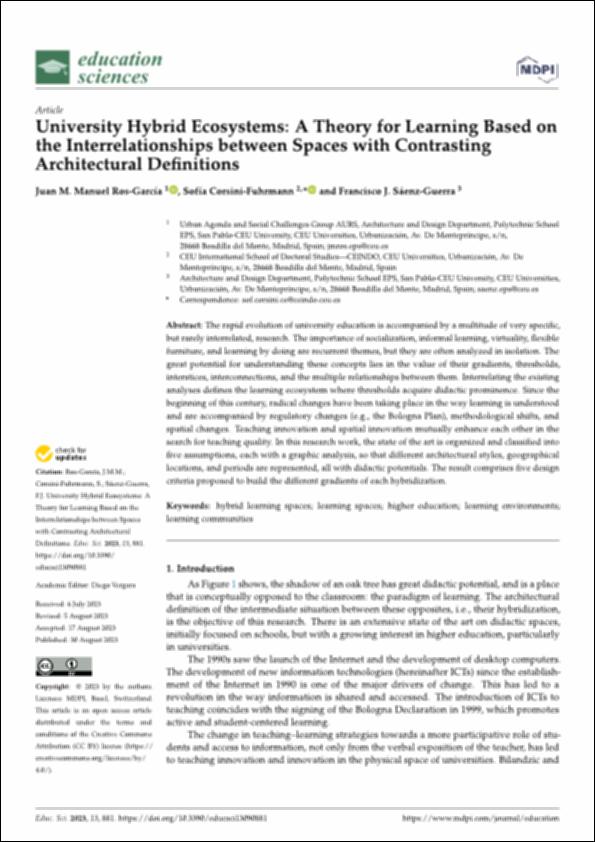Por favor, use este identificador para citar o enlazar este ítem:
http://hdl.handle.net/10637/15783University Hybrid Ecosystems: A Theory for Learning Based on the Interrelationships between Spaces with Contrasting Architectural Definitions
| Título : | University Hybrid Ecosystems: A Theory for Learning Based on the Interrelationships between Spaces with Contrasting Architectural Definitions |
| Autor : | Ros García, Juan Manuel Corsini Fuhrmann, Sofía Sáenz Guerra, Francisco Javier |
| Materias: | Learning spaces; Higher education |
| Editorial : | MDPI |
| Citación : | Ros-García, J.M.M.; Corsini-Fuhrmann, S.; Sáenz-Guerra, F.J. University Hybrid Ecosystems: A Theory for Learning Based on the Interrelationships between Spaces with Contrasting Architectural Definitions. Educ. Sci. 2023, 13, 881. https://doi.org/10.3390/ educsci13090881 |
| Resumen : | The rapid evolution of university education is accompanied by a multitude of very specific, but rarely interrelated, research. The importance of socialization, informal learning, virtuality, flexible furniture, and learning by doing are recurrent themes, but they are often analyzed in isolation. The great potential for understanding these concepts lies in the value of their gradients, thresholds, interstices, interconnections, and the multiple relationships between them. Interrelating the existing analyses defines the learning ecosystem where thresholds acquire didactic prominence. Since the beginning of this century, radical changes have been taking place in the way learning is understood and are accompanied by regulatory changes (e.g., the Bologna Plan), methodological shifts, and spatial changes. Teaching innovation and spatial innovation mutually enhance each other in the search for teaching quality. In this research work, the state of the art is organized and classified into five assumptions, each with a graphic analysis, so that different architectural styles, geographical locations, and periods are represented, all with didactic potentials. The result comprises five design criteria proposed to build the different gradients of each hybridization. |
| Descripción : | Los contenidos de este artículo son parte del proyector titulado: "University learning as social space. Didactic places for teaching activities and their different degrees of sociability. Architectural criteria for learning enhancers" |
| URI : | http://hdl.handle.net/10637/15783 |
| Derechos: | http://creativecommons.org/licenses/by-nc-nd/4.0/deed.es Open Access |
| ISSN : | 2227-7102 |
| Fecha de publicación : | 30-ago-2023 |
| Centro : | Universidad San Pablo-CEU |
| Aparece en las colecciones: | Escuela de Politécnica Superior |
Los ítems de DSpace están protegidos por copyright, con todos los derechos reservados, a menos que se indique lo contrario.


